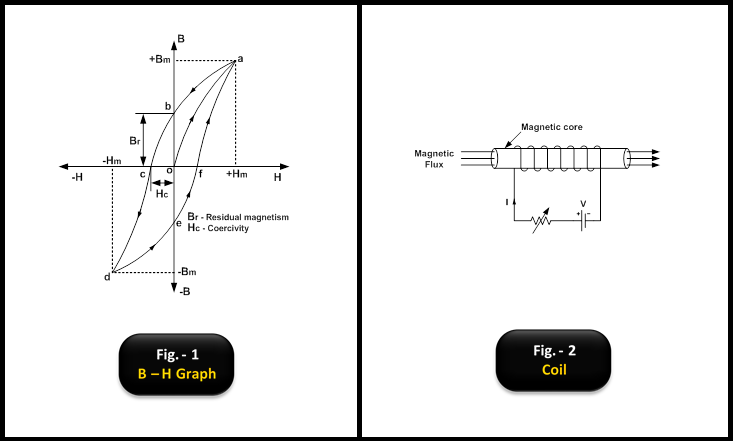Explain the terms : - 1. Residual magnetism 2. Coercive Force.
- Hysteresis of a magnetic material is a property by virtue of which the flux density (B) of this material lags behind the magnetizing force (H).
- Hysteresis loop is a four quadrant B – H graph from where the hysteresis loss, coercive force and retentively of magnetic material are obtained.
- To understand hysteresis loop, we suppose to take a magnetic material to use as a core around which insulated wire is wound.
- The coil is connected to the supply (DC) through variable resistor to vary the current I, as the current I is directly proportional to the value of magnetizing force (H).
- When supply current I = 0, so no existence of flux density (B) and magnetizing force (H). The corresponding point is o in the graph beside.
- When current is increased from zero value to a certain value, magnetizing force and flux density both are set up and increased following the path o to a.
- For a certain value of current, flux density becomes maximum (Bm). The point indicates the magnetic saturation or maximum flux density of this core material.
- When the value of current is decreased from its value of magnetic flux saturation, H is decreased along with decrement of B not following the previous path rather following the curve a to b.
- The point b indicates H = 0 for I = 0 with a certain value of B. This lagging of B behind H is called hysteresis. The point b explains that after removing of magnetizing force (H), magnetism property with little value remains in this magnetic material and it is known as residual magnetism (Br) or residual flux density.
- The point b indicates H = 0 for I = 0 with a certain value of B. This lagging of B behind H is called hysteresis. The point b explains that after removing of magnetizing force (H), magnetism property with little value remains in this magnetic material and it is known as residual magnetism (Br) or residual flux density.
- The point b indicates H = 0 for I = 0 with a certain value of B. This lagging of B behind H is called hysteresis. The point b explains that after removing of magnetizing force (H), magnetism property with little value remains in this magnetic material and it is known as residual magnetism (Br) or residual flux density.
- The point b indicates H = 0 for I = 0 with a certain value of B. This lagging of B behind H is called hysteresis. The point b explains that after removing of magnetizing force (H), magnetism property with little value remains in this magnetic material and it is known as residual magnetism (Br) or residual flux density.
- The point b indicates H = 0 for I = 0 with a certain value of B. This lagging of B behind H is called hysteresis. The point b explains that after removing of magnetizing force (H), magnetism property with little value remains in this magnetic material and it is known as residual magnetism (Br) or residual flux density.
